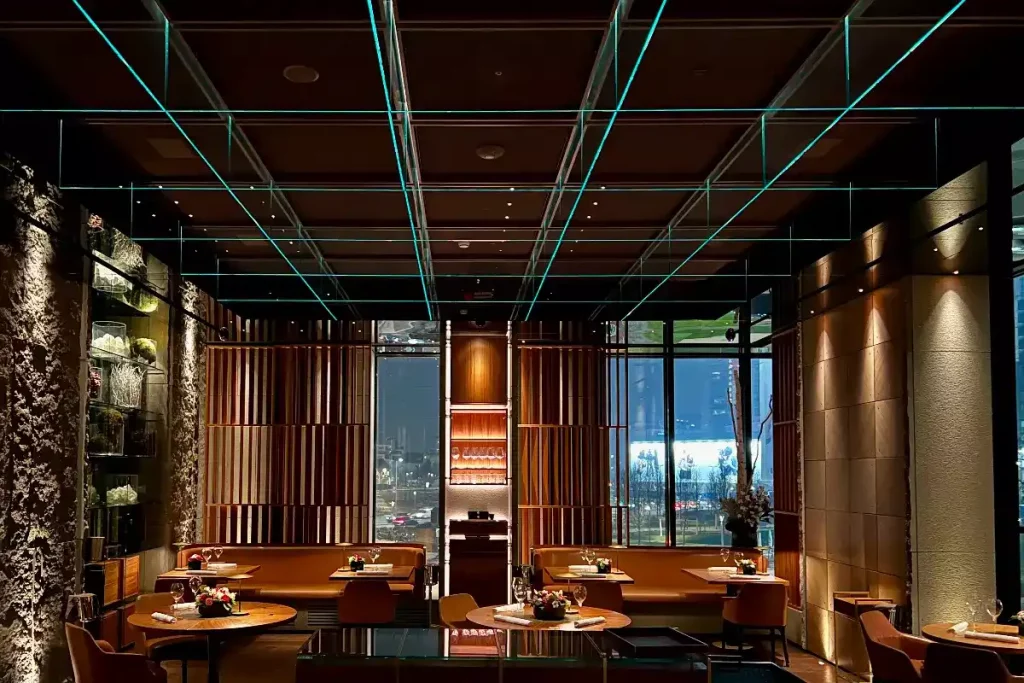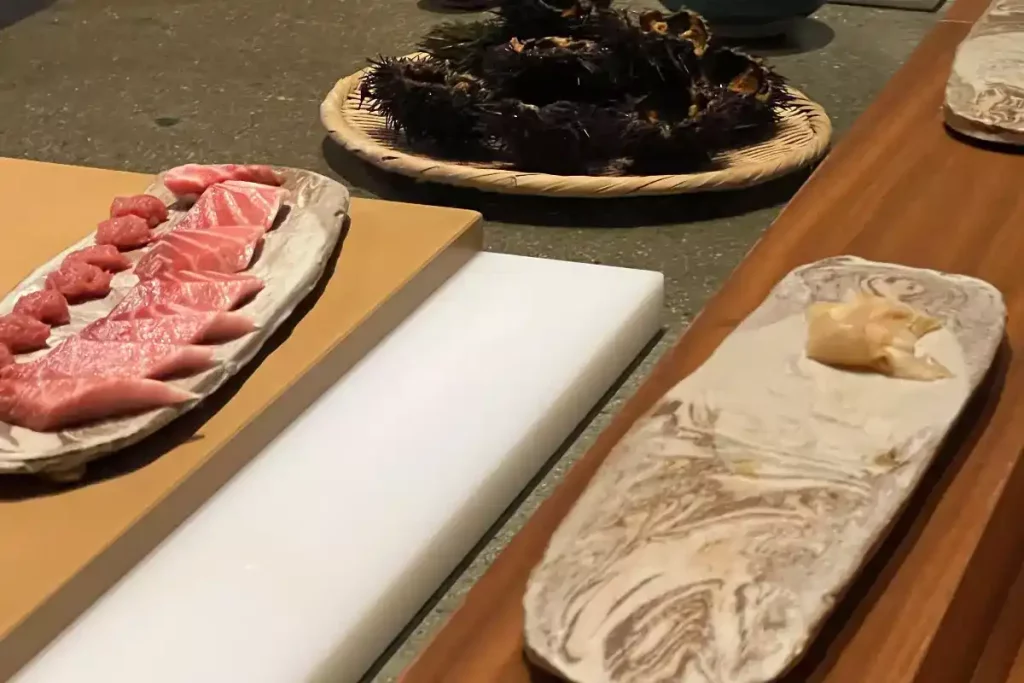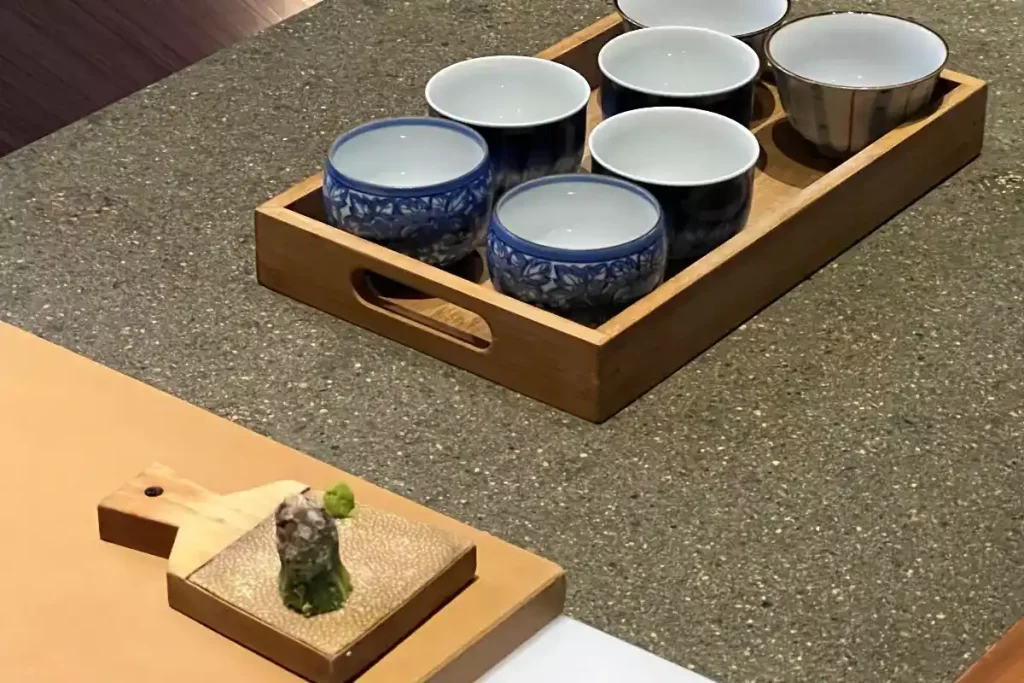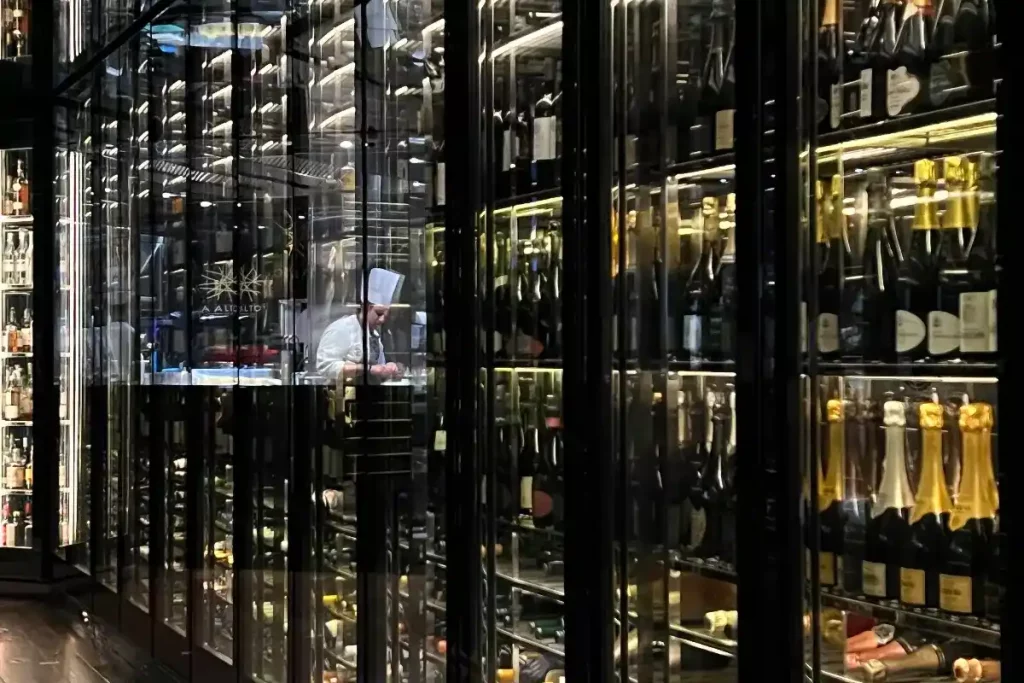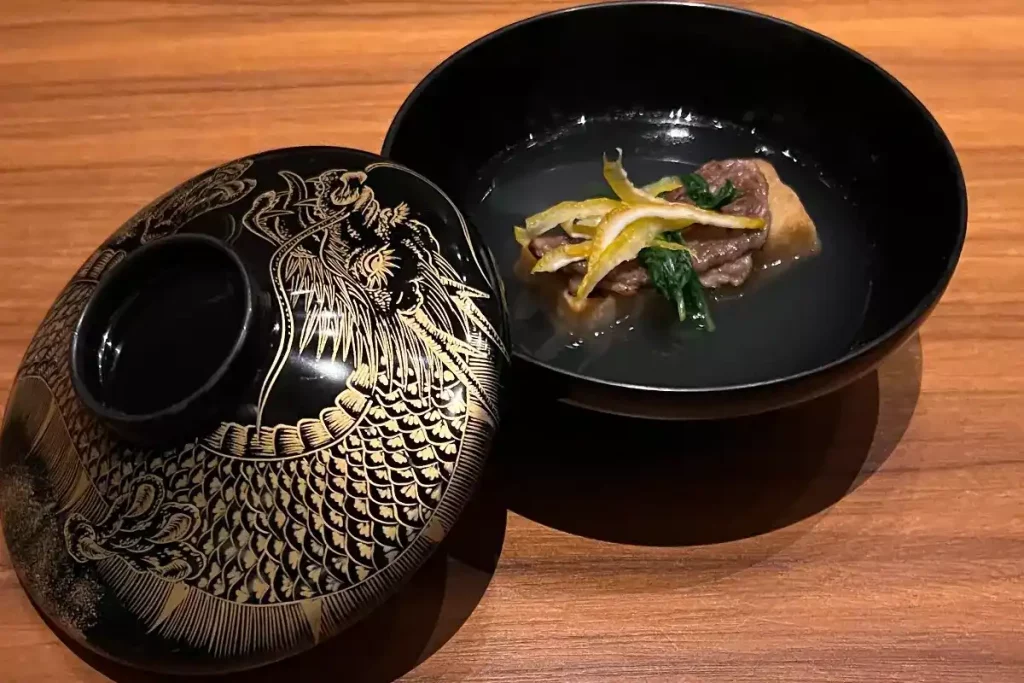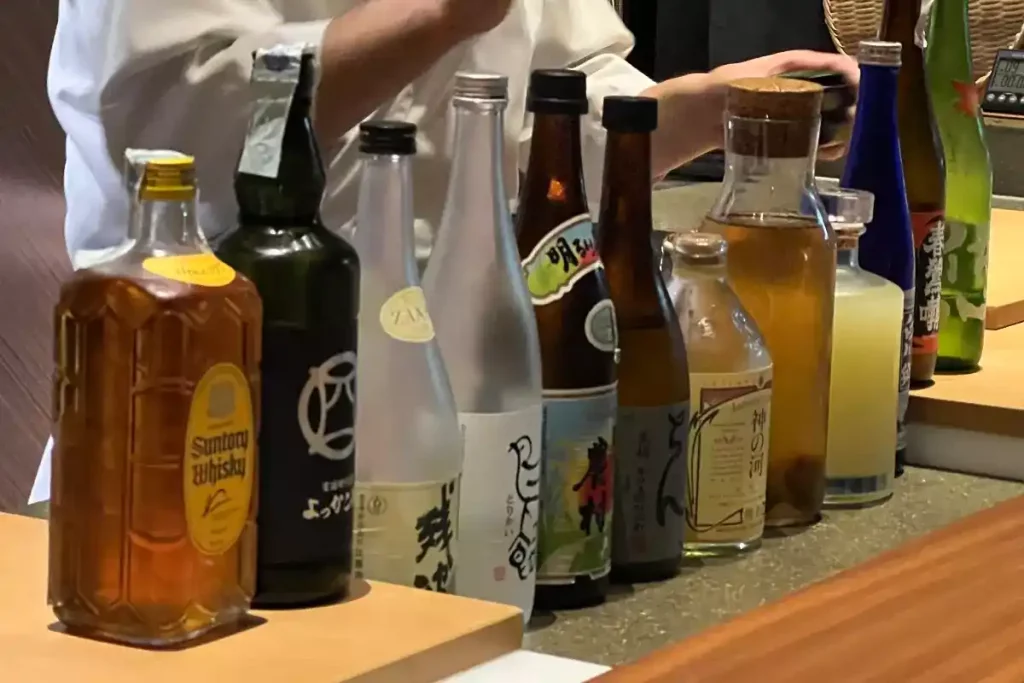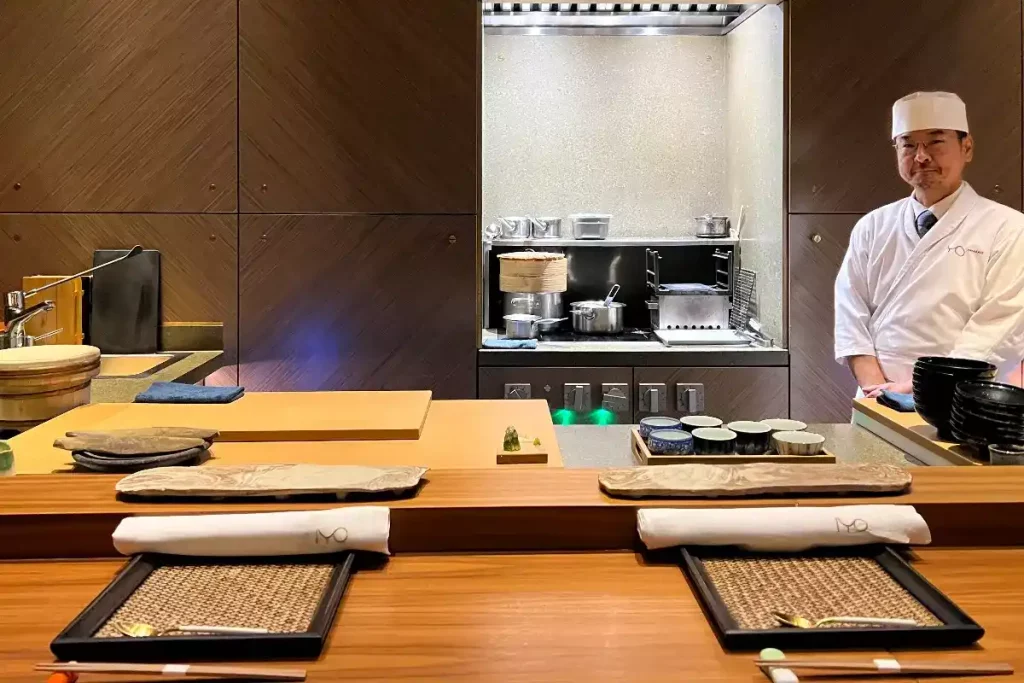The art of Nigiri, kashihikari rice, Edomae-zushi, and all the master’s tools: IYO Omakase’s sushi counter is like entering the theater and breaking the fourth wall – Masashi Suzuki explains the food he has prepared and hands it to the diners
IYO Omakase, in Piazza Alvar Aalto, on the first floor of Torre Solaria
An experience for just seven people, sitting around the sushi counter: it’s like being in the theater and breaking the fourth wall – you’re part of the show when the sushi master unfolds the food he’s just prepared and hands it to you. Claudio Liu, a lover and connoisseur of the Rising Sun, opened IYO Omakase in 2019. He brought to Milan the sushi counter, a ritual found in Tokyo and Japan. It is only for 7 people, with 2 sushi masters cooking, telling about the raw materials and the soul of each dish.
Rice is the starting point. At IYO Omakase, Master Masashi Suzuki uses sushi rice handcrafted in Japan and imported especially for him. Koshihikari rice is considered the original sushi rice, renowned for its delicately sweet flavor, nutty notes, and slight stickiness. that make it especially suitable for sushi.
Koshihikari Rice: History, Cultivation, and Characteristics
Koshihikari rice dates back to the 1950s in Japan, in the Fukui region. It is the result of patient crossbreeding and selection by local farmers aimed at creating a high-quality rice variety in terms of healthiness, flavor, texture, and appearance. Its name, “Koshihikari,” comes from the combination of two Japanese words: “Koshi,” referring to the region in Niigata Prefecture where this variety was developed, and “Hikari,” meaning “light.”
Despite being a relatively recent phenomenon, Koshihikari’s intensive cultivation has made it the most sought-after rice for Japanese people. Since the end of the post-World War II crisis in the 1960s, Japanese preferences have shifted, and high productivity hase turned into a pursuit of ever increasing quality, leading to the expansion of Koshihikari cultivation. With the growing development of Koshihikari cultivation in Japan, increasingly refined agronomic techniques have been adopted to achieve high quality but also effective adaptation to different environments. This is during germination and cold tolerance during maturation.
Koshihikari rice is special for its tender and sticky texture. This characteristic is highly appreciated in Japanese cuisine, especially in sushi preparation and traditional dishes like ochazuke (rice in broth). Its gentle sweetness and delicate aroma also make it suitable for accompanying a wide variety of dishes, from raw fish to grilled meat. The slender, small grains of Koshihikari rice, combined with a lot of starch, contribute to the right stickiness when cooked.
Treatment of sushi rice
This rice requires thorough washing to remove excess starch and achieve the desired consistency. This delicate process preserves grain integrity, preventing breaking during cooking. After washing, the rice is cooked and transferred to a hangiri, a specially designed wooden container. It is cooled with a fan called a uchiwa. During this phase, a seasoning based on rice vinegar, salt, sugar, and kombu seaweed, known as sushizu, is added, giving the rice its characteristic shiny appearance and preserving its softness. Once seasoned, the rice is transferred to an ohitsu, another wooden container, and covered with a damp cloth. This is done to maintain the right temperature and humidity.
Nigiri preparation also requires careful attention to rice temperature. It’s all about details, balance, and harmony, as each gesture contributes to creating the desired culinary experience. Sushi ritual is accompanied by traditional tools, many dating back to the last century. These tools are essential for achieving excellence. For example, rice seasoning is carried out using two main tools: the hangiri, a cypress wood tub that gently mixes the rice to achieve its distinctive brightness, and the shamoji, a wooden paddle used to stir the rice seasoned with sushizu without breaking the grains.
IYO Omakase – sushi master Masashi Suzuki
Sushi master Masashi Suzuki offers only the finest raw materials available on the market every day, selected based on seasonality. He cooks them in a way that enhances them to the fullest, within a carefully planned journey that is never the same.
Born in Tokyo in 1976, he started working in restaurants in Yamanashi Prefecture. During the day, he worked as a kitchen boy, observing the sushi masters; in the evening, he replicated their actions with the fish he bought at the market. In 2001, he moved to Milan, where he gained experience at sushi counters of Endo, Sol Levante, and Osaka. These counters are among the leading Japanese restaurants in Italy. In 2018, he joined Claudio Liu’s team. Since 2019 he has been the sushi master at IYO Omakase, following the tradition of Edomae-zushi, the oldest and most rigorous school.
What is Edomae-zushi? Raw materials, simplicity, precision, and aesthetic care
Edomae-zushi represents a traditional and revered form of Japanese sushi, rooted in the deep culinary traditions of Edo, the ancient name for Tokyo. This style of sushi, characterized by meticulous preparation and absolute respect for the freshness of the ingredients, offers a gastronomic experience that celebrates Japan’s history and culinary culture. The term “Edomae” literally means “in front of Tokyo,” indicating the origin of the sushi prepared in the region surrounding Tokyo Bay during the Edo era (1603-1868). During this historical period, sushi was a popular food sold in local markets and along city streets. This was done taking advantage of the wide range of fresh fish caught in the surrounding waters.
One of the distinctive features of Edomae-zushi is respect for seasonality and freshness. Edomae chefs select fish based on seasonal availability and quality, ensuring that each piece of sushi reflects the best offerings of the moment. This approach ensures vivid and authentic flavors, capturing the essence of the season and local waters. Another key element of Edomae-zushi is the technique of preserving and preparing fish. In the past, due to the lack of refrigeration, fish were preserved using marinating and fermenting methods to prolong their freshness and enhance their flavor. Even today, this practice remains an essential part of sushi preparation, adding depth of taste and complexity to the dishes.
Each piece of sushi is prepared with care and attention to detail. This includes the processing of the fish to the composition of the rice seasoned with rice vinegar. This attention to craftsmanship ensures that each sushi bite is a culinary work of art. Edomae-zushi celebrates the aesthetics and beauty of food: this respect for the visual aspect reflects Japanese culinary culture’s consideration for art and tradition.
I love all cuisines; each has its beauty and nuances. In Italian cuisine, there is love; in Chinese cuisine, there is technique. Japanese cuisine is about balance, cleanliness, exalting raw materials, and relentless search for umami. Japanese people love the most complicated dish: nigiri: complex and simple, as Claudio Liu says.
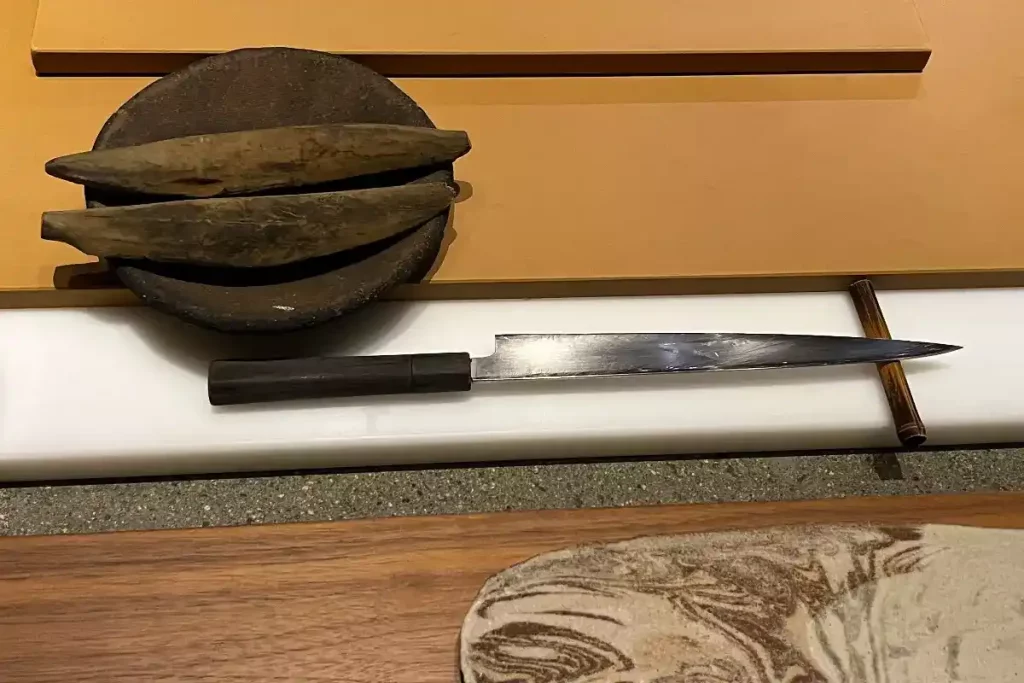
The preparation of Nigiri at IYO Omakase
Nigiri are the true protagonists of the Edomae style; they are prepared in front of guests and served one after another, following a coded sequence of increasing fattiness and umami: white fish, red – like tuna in its different varieties – marinated, and finally cooked – like eel. Directly from the sushi master’s hands, they are eaten strictly with the hands, in a single bite and without the need for additional condiments. However, nigiri are only part of the IYO Omakase experience, which also includes freshly cooked meat and fish dishes, soups, and sashimi.
All the sushi master’s tools are ready for use, yet perfectly placed in space, as in a movie set. The sushi master moves with ease, precision, and speed. Knives, sharkskin grater for wasabi, terracotta bowls and plates, or the sumibiyaki grill come to life behind the counter.
The design of the IYO Omakase sushi counter and Aalto
The IYO Omakase sushi counter is designed by Maurizio Lai. We are in Alvar Aalto Square, on the first floor of the Solaria Tower: outside the window are Milan’s lights – international, modern, future-oriented.
The room is characterized by an entrance wall made of Brise Soleil in canaletto walnut. This allows glimpsing both the interior environment and the view of the Porta Nuova skyline through the windows. In the interior, gray-green porphyry and canaletto walnut wood create a warm and sophisticated atmosphere. Light is a key element to enhance wooden, stone, and glass surfaces, creating diverse and engaging atmospheres.
The separation between the IYO Omakase sushi counter and the Aalto restaurant room is outlined by a partition composed of porphyry slabs with a split finish. These slabs come from the only quarry in Trentino. Wood covers walls and ceilings. Details in glass, brass, and natural leather enrich the environment, while each piece of furniture and decoration has been custom-designed to offer a surprising experience for guests. Sake barrels strategically arranged, soy dishes revealing Mount Fuji and Itsukushima Shrine when soy sauce is poured, ceramic ochoko for sake, vegetable-shaped ceramic chopstick rests, and wooden chopsticks enrich the culinary experience.

The restaurant entrance marks the transition to an almost dreamlike atmosphere. This is characterized by a compass composed of floating glass slabs and smoked mirrors. This creates an effect of space dilation through transparency and infinite reflections. Once this threshold is crossed, a luminous installation and an organic desk introduce the theme of dialogue between form and material. This theme permeates other restaurant spaces.
The overall space of the Aalto restaurant, 320 square meters, has been conceived as a path that embraces the open kitchen, the wall-mounted wine cellar, and two distinct environments dedicated to gastronomic experiences: the Sushi Counter and the Gastronomic Restaurant. The kitchen, enclosed in a glass showcase, is a transparent environment that opens both to the interior of the premises and to the outdoor square. This creates a direct connection between the restaurant and the surrounding environment.
The cellar at IYO Omakase
Accompanying the gastronomic experience are sake, distilled spirits, liquors, and Japanese whisky. Teas and infusions, such as Sobacha, a buckwheat infusion, and Genmaicha, a precious blend of green tea and roasted popped rice. Right behind the guests, the sake wooden barrels, kazaridaru, invite tasting. However, the wine list boasts 700 references, with a preference for Burgundy, sparkling wines, champagne, and biodynamic and natural wines – for a range of pairings that span from the most traditional to the most contemporary.
The custom-built wall cellar is 3.5 meters by 10 meters and can hold up to 1,600 bottles, with 6 different temperature zones.
Claudio Liu
Born in 1982 in China, raised in Emilia, in Correggio, he took his first steps in the industry at a family restaurant in Milan. In 2007, at just 24 years old, he opened IYO, the first “non-Italian cuisine” restaurant in Italy to receive a Michelin star in the 2015 Guide. In 2018, he launched AJI, the first delivery and takeaway format for high-quality sushi and oriental cuisine in the country. In 2019, he inaugurated IYO Omakase, the sushi counter in pure traditional Japanese style, and AALTO, the fine dining restaurant with free, boundary-less cuisine. The restaurant was immediately awarded a Michelin star for the 2021 Guide. Claudio Liu currently leads the four IYO Group establishments in Milan.
Matteo Mammoli
